The City Walls
Chester's City Walls form virtually a complete two mile (3 km) circuit around the historic city centre, from which many of the city's key heritage sites can be seen. The walls comprise the most complete Roman and medieval defensive town wall system in Britain.
The Roman Gardens from the city walls

The red sandstone walls have their origin in Roman times, when Chester was known as Dewa, and were originally a rampart of earth and turf surmounted by a wooden palisade. From about 100 AD they were reconstructed using sandstone although they were succesively altered in the Saxon and medieval periods, some time Roman stones, including tombstones, were known to have been used in the repairs. The Normans extended the original circuit, adding towers, gates and a ditch. Along the northern sections of the wall, the Roman foundations are still visible.
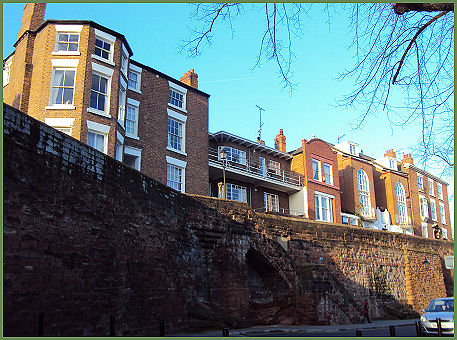
The walls were damaged during the siege of Chester, which took place during the Civil War. Roundhead troops bombarded the walls with canon in attempt to breech them. Repairs to damage caused at this period can still be clearly seen in the section of the walls which adjoins the Roman Gardens.
During the seventeenth century, when the walls became largely redundant in terms of defence, they were turned into a fashionable two mile circular promenade. Views from the walls encompass Chester and the surrounding countryside,and stretch as far as the Welsh mountains. Metal panels explaining the different parts of the route are positioned regularly and at points of interest. The walk is approximately rectangular in plan, on a continuous elevated walkway, apart from a short section on the south of the city. It incorporates medieval structures, including Bonewaldesthorne's Tower, attached to the Water Tower at the northwest corner, Pemberton's Parlour and Morgan's Mount on the north section of the walls, Phoenix Tower, Thimbleby's Tower and Barnaby's Tower on the east section of the walls, and the base of a drum tower on the south section.
Bridgegate
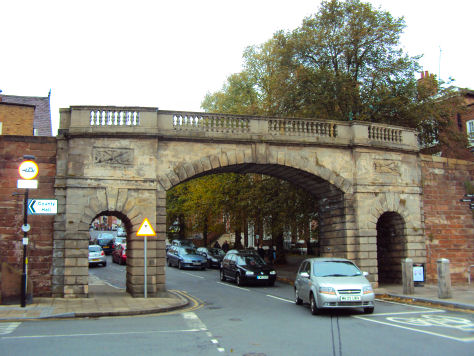
The four main gates the East and North gates, the Bridgegate and the Watergate were rebuilt in the eighteenth and nineteenth centuries. Eastgate occupies the site of the eastern gateway of the Roman fortress and was incorporated into the medieval gate. The Eastgate Clock, one of Chester's most famous landmarks, surmounts the present Eastgate archway and spans the walkway of the walls. The archway was built 1768 to 1769 by Richard, Earl of Grosvenor, the clock was placed above to commemorate Queen Victoria's diamond jubilee in 1897 and was designed by the architect John Douglas. Douglas played a major part in the city's Victorian half timbered architectural revival.
The Eastgate clock
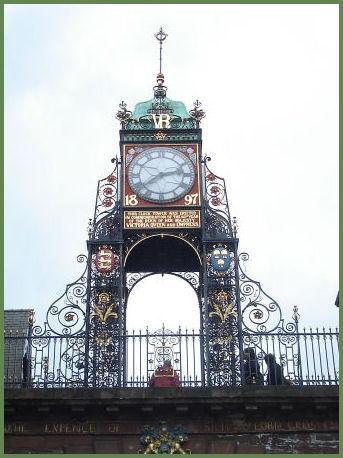
Newgate stands just outside the southern defences of the Roman legionary fortress, The present arched Northgate dates from 1910, it replaced a medieval gateway to the city known as the Wolfgate which had a narrow entrance and incorporated towers and the city gaol.
Newgate
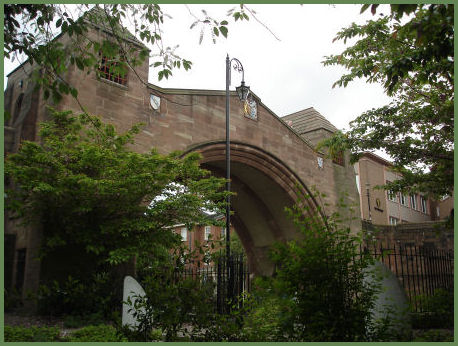
Beside the Newgate, the remains of one of the 26 towers which were built around the walls in Roman times is still visible. The South East Angle tower was constructed as part of the Roman fortress in AD 79. It is the south-east corner tower of the 'playing card' shaped standard fortress. For protection the tower was built inside the corner rather than on the outside as in the medieval style. The tower was built of thick masonry and was used as a lookout for the fort.
Remains of the Roman South East Angle Tower
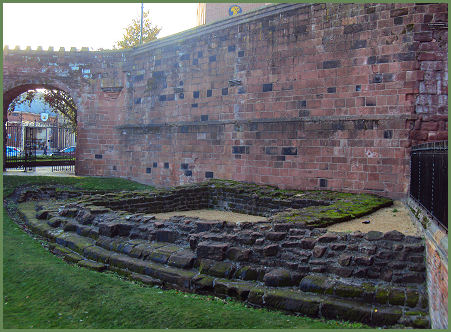
The curious Pemberton's Parlour occupies the site of a medieval watch tower, which was known as Dille's Tower and later, the Goblin Tower. The present structure is an eighteenth century reconstruction. Its name derives from its use by John Pemberton, who owned a rope works below and used the tower to supervise his workmen. There are two Cartouches on the Parlour which were carved by John Tilston and a plaque recording the names of past Mayors and Mivengers, who were the officers responsible for the upkeep of the wall.
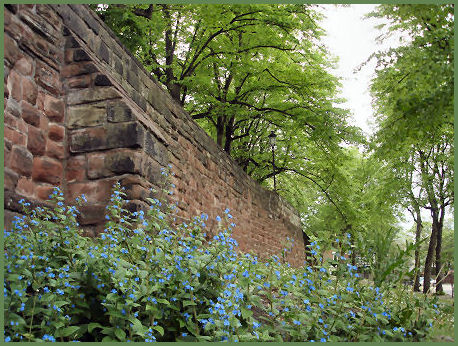
Watergate dates from 1788 and was designed by Joseph Turner. In Medieval times, the Watergate gateway provided access to the river and port. At this time the river came up to the City Walls at this point, although by the eighteenth century, due to silting, it had diverted to the West.
Standing on the North-East corner of the city walls is the Phoenix Tower, also known as King Charles' Tower. On the 24th of September 1645, during the Civil War, King Charles I stood on the tower and watched his army defeated in the Battle of Rowton Heath.
The walkway by the Cathedral
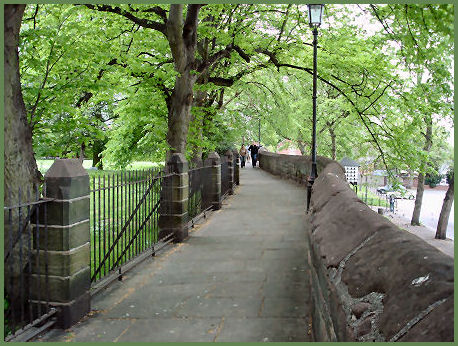
Charles entered the city on the evening of the 23rd of September 1645. The Parliamentarians, lead by Sydenham Poyntz, were informed that Charles had entered the city, and marched through the night to meet the Royalist forces. Charles watched the ensueing batle from the tower. Battle was opened with a Parliamentary charge, which the Royalists drove back, but they were pushed back to the eastern suburbs of the city and finally driven from the field. The king was moved to the cathedral tower, were he was narrowly missed by a bullet fired by a Parliamentary sniper.
The famous wishing steps on the walls date from 1785 and were constructed to join two levels of the Walls. Tradition relates that any person who makes a wish at the foot of the steps and then traverses up and down them without taking a breadth will be granted their wish!
